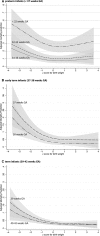Effect of Fetal Growth on 1-Year Mortality in Neonates With Critical Congenital Heart Disease
- PMID: 30371167
- PMCID: PMC6201429
- DOI: 10.1161/JAHA.118.009693
Effect of Fetal Growth on 1-Year Mortality in Neonates With Critical Congenital Heart Disease
Abstract
Background Infants with critical congenital heart disease ( CCHD ) are more likely to be small for gestational age (GA). It is unclear how this affects mortality. The authors investigated the effect of birth weight Z score on 1-year mortality separately in preterm (GA <37 weeks), early-term (GA 37-38 weeks), and full-term (GA 39-42 weeks) infants with CCHD . Methods and Results Live-born infants with CCHD and GA 22 to 42 weeks born in California 2007-2012 were included in the analysis. The primary predictor was Z score for birth weight and the primary outcome was 1-year mortality. Multivariable logistic regression was used. Results are presented as adjusted odds ratios and 95% confidence intervals ( CIs ). The authors identified 6903 infants with CCHD . For preterm and full-term infants, only a Z score for birth weight <-2 was associated with increased mortality compared with the reference group ( Z score 0-0.5, adjusted odds ratio, 2.15 [95% CI , 1.1-4.21] and adjusted odds ratio, 3.93 [95% CI , 2.32-6.68], respectively). In contrast, in early-term infants, the adjusted odds ratios for Z scores <-2, -2 to -1, and -1 to -0.5 were 3.42 (95% CI , 1.93-6.04), 1.78 (95% CI , 1.12-2.83), and 2.03 (95% CI , 1.27-3.23), respectively, versus the reference group. Conclusions GA seems to modify the effect of birth weight Z score on mortality in infants with CCHD . In preterm and full-term infants, only the most severe small-for-GA infants ( Z score <-2) were at increased risk for mortality, while, in early-term infants, the risk extended to mild to moderate small-for-GA infants ( Z score <-0.5). This information helps to identify high-risk infants and is useful for surgical planning.
Keywords: birth weight Z score; congenital cardiac defect; congenital heart disease; fetal growth; mortality.
Figures


Comment in
-
Growth in Congenital Heart Disease: Outcome or Predictor?J Am Heart Assoc. 2018 Sep 4;7(17):e010262. doi: 10.1161/JAHA.118.010262. J Am Heart Assoc. 2018. PMID: 30371175 Free PMC article. No abstract available.
References
-
- Dolk H, Loane M, Garne E; a European Surveillance of Congenital Anomalies (EUROCAT) Working Group . Congenital heart defects in Europe: prevalence and perinatal mortality, 2000 to 2005. Circulation. 2011;123:841–849. - PubMed
-
- van der Linde D, Konings EEM, Slager MA, Witsenburg M, Helbing WA, Takkenberg JJM, Roos‐Hesselink JW. Birth prevalence of congenital heart disease worldwide. J Am Coll Cardiol. 2011;58:2241–2247. - PubMed
-
- Mozaffarian D, Benjamin EJ, Go AS, Arnett DK, Blaha MJ, Cushman M, Das SR, de Ferranti S, Després J‐P, Fullerton HJ, Howard VJ, Huffman MD, Isasi CR, Jiménez MC, Judd SE, Kissela BM, Lichtman JH, Lisabeth LD, Liu S, Mackey RH, Magid DJ, McGuire DK, Mohler ER, Moy CS, Muntner P, Mussolino ME, Nasir K, Neumar RW, Nichol G, Palaniappan L, Pandey DK, Reeves MJ, Rodriguez CJ, Rosamond W, Sorlie PD, Stein J, Towfighi A, Turan TN, Virani SS, Woo D, Yeh RW, Turner MB; American Heart Association Statistics Committee, Stroke Statistics Subcommittee . Heart disease and stroke statistics—2016 update: a report from the American Heart Association. Circulation. 2016;133:e38–e360. - PubMed
-
- Triedman JK, Newburger JW. Trends in congenital heart disease: the next decade. Circulation. 2016;133:2716–2733. - PubMed
Publication types
MeSH terms
Grants and funding
LinkOut - more resources
Full Text Sources
Medical

